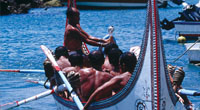
| Category | Early Registration | Normal Registration |
| Half Day(4 hours) | Half Day(4 hours) | |
| Member (IEEE/MTS) | 6,000 NTD | 7,200 NTD |
| Life-Member (IEEE/MTS) | 2,250 NTD | 3,000 NTD |
| Non-Member | 7,500 NTD | 8,700 NTD |
| Student Member | 6,000 NTD | 7,200 NTD |
| Student Non-Member | 6,000 NTD | 7,200 NTD |
| Date | Time | 202A | 202B | 203A | 203B |
|
April 7 Monday |
08:30-12:00 |
TUTORIAL 1
The ABC's of underwater acoustic communications (T.C. Yang) |
TUTORIAL 2
Optical Methods in Oceanography (Weilin Hou) |
TUTORIAL 3
Introduction to Sediment Acoustics (Nicholas Chotiros) |
TUTORIAL 4
Broadband acoustics: An emerging technology for studying fish and zooplankton (Timothy K. Stanton) |
| 12:00-13:20 | LUNCH | ||||
| 13:20-17:00 |
TUTORIAL 5
Numerical models for three-dimensional underwater sound propagation (Ying-Tsong Lin) |
TUTORIAL 6
Time-frequency Analysis Techniques for Oceanography (Jian-Jiun Ding) |
|
||
T.C. Yang
Title: The ABC's of underwater acoustic communications: An intuitive introduction to the basic technologies, key issues and advanced concepts for non-expert
Description
This tutorial is intended for people who have no digital communication background but want to know what it is about, what are the key technical issues, what are the state of the art, and some advanced technologies being pursued. The field of digital communication is filled with jargon, and underwater acoustic communication is no exception. To be rigorous, technical papers often contain heavy mathematics which makes it difficult for non-experts to learn. This course will give a tutorial introduction of the basic concepts and approaches in underwater acoustic communications using simple math and simple examples, starting with various types of signal modulations, signal generations, followed by channel equalization, demonstrated using simple Matlab programs. Then it will discuss: (1) what are the properties of the underwater acoustic channels that impact the performance of underwater acoustic communications, (2) what are the three different approaches to solve the inter-symbol interference problems; and (3) what are the state of the art of the technology and some of the advanced concepts/approaches currently under investigation. The course is intended to equip the audience with some basic knowledge of the field so that they shall be able to understand the general ideas when someone gives a technical talk on underwater acoustic communications.
Biography
Dr. Yang is currently a National Science Counsel Chair Professor at the Inst. of Applied Marine Physics and Undersea Technology, College of Marine Science, Nat. Sun Yat-Sen Univ. Kaohsiung, Taiwan. Previous to this job, he spent 32 years working at the Naval Research Laboratory, Washington, DC, serving as Head of the Arctic Section, Dispersive Wave Guide Effects Group, and acting Head of the Acoustic Signal Processing Branch. He has worked on underwater acoustic communications for more than 15 years. His current research focuses on: (1) environmental impacts on underwater acoustic communications and networking, exploiting the channel physics to characterize and improve performance, and (2) environmental acoustic sensing and signal processing issues aimed at improving the effectiveness of distributed networked sensing. In earlier years, he pioneered matched mode processing for a vertical line array, and matched-beam processing for a horizontal line array. Other areas of research included geoacoustic inversions, waveguide invariants, effects of internal waves on sound propagation in shallow water, Arctic acoustics, etc. He is a fellow of the Acoustical Society of America.
Nicholas P. Chotiros
Title: Introduction to Sediment Acoustics
Description
In many applications of underwater acoustics, such as communications, target detection and particularly environmental assessment, acoustic interactions with the seabed are important. Therefore, it is necessary to have some understanding of the nature of the seabed and how it influences the sound field. This is a subject that has been studied over several decades. The early work of Hamilton [Acoust. Soc. Am., 68 (1980)] will be reviewed and some popular models will be reviewed [APL-UW 9407]. The development of the acoustics of the seabed will be described, including the Biot model. The short course follows the following outline:
1. Seabed classification
2. Acoustic models of the sediment
3. Sound speed and attenuation in the sediment
4. Reflection and scattering of sound
5. Environmental assessment for the seabed
Instructor Biography
Nicholas Chotiros received a B.A. degree in Engineering from Cambridge University, and a Ph. D. from University of Birmingham, UK. From 1974 to 82, he was a lecturer at the University of Birmingham. Since 1982, he has been with the Applied Research Laboratories, The University of Texas at Austin, current position Research Scientist, and worked on projects in underwater acoustics. From 2002 to 2005, he served as a program officer at the Office of Naval Research. He has served in NSF and DoD advisory groups. He is a Fellow of the Acoustical Society of America (ASA), and member of Institute of Electrical and Electronics Engineers (IEEE). Research interests include: High frequency environmental acoustics: bottom backscatter and penetration analysis. Current work concerns sediment characterization and acoustic modeling.
Weilin “Will” Hou
Title: Optical Methods in Oceanography
Description
Oceanography is inherently interdisciplinary, due to both the nature of the subject, as well as diverse approaches associated with research and applications. This tutorial covers both basic principles, as well as cutting edge research and applications related to optical methods in ocean studies. The non-exhaustive list would include optical properties of the water, diver visibility, active imaging underwater, ocean color remote sensing, lidar, thermo & microwave sensing, and conclude with brief discussion on sampling and instrumentations. This course gives a quick but in-depth overview to those who are interested in exploring new techniques using optics, both students as well as professionals from other disciplines. Dr. Hou’s recently finished book, “Ocean Sensing and Monitoring: Optics and other Methods”, can be used as a course reference.
Instructor Biography
Head, Ocean Hydro Optics Sensors and Systems Section U.S. Naval Research Laboratory, Stennis Space Center, MS 39529, USA. Dr. Hou has been active in the field of optics and oceanography for over 20 years. He earned his BS in physics from Fudan University and his PhD from University of South Florida. Dr. Hou has chaired numerous conferences and sessions on underwater imaging, remote sensing, unmanned underwater vehicles and data management. Dr. Hou has over 60 published papers, 4 patents, and editor of 5 conference proceedings. Dr. Hou is the author of the textbook on “Ocean Sensing and Monitoring: Optics and other Methods”.
Timothy K. Stanton
Title: Broadband acoustics: An emerging technology for studying fish and zooplankton.
Overview
Active acoustics has been used for decades to study fish and zooplankton. The goal is to study the spatial and temporal variability of the organisms and to relate the acoustic data to meaningful biological parameters such as size and numerical density of the organisms. Traditionally, narrowband echosounders have been used in the applications. These echosounders operate at a single frequency or with several single frequency channels. However, there are many limitations in the use of narrowband technology and its usefulness has generally been limited to cases in which there are only single-size, single species present. In cases of more complex assemblages in which there are multiple sizes and species present, the ambiguities in interpreting narrowband data are too great for effective use of that technology. Broadband acoustics has recently emerged in the field of bioacoustics as a tool to potentially significantly improve studies of fish and zooplankton over use of conventional narrowband systems. In this context, “broadband” is defined as continuous coverage of frequencies over a significant range of frequencies, such as an octave band and greater (whereas “narrowband” in this context is typically a band that is about 10% or less of the center frequency). With greater spectral coverage, there is correspondingly more information contained in the broadband signal. With this additional information in the broadband signal, ambiguities normally associated with interpretation of narrowband data can be reduced and, in some cases, eliminated.
Broadband systems are becoming commercially available for bioacoustics applications and more are planned to be available. With this recent emergence of broadband systems, it is timely to review the fundamental concepts, advantages, and methodologies associated with broadband approaches.
In this tutorial, the principles and applications of broadband active acoustics for use in studying fish and zooplankton are presented. All aspects of broadband acoustics are covered, including examples of broadband signals, signal processing (including matched filter processing), acoustic scattering theory, relating parameters of matched filtered signals to scattering features of marine organisms, illustration of concepts from laboratory experiments, broadband calibration methods, ocean instrumentation, and application of broadband methods at sea for studies of fish and zooplankton. Key references will be given for each topic.
Target audience
Anyone interested in use of sound to study marine organisms: Scientists, engineers, and managers; applications include fisheries and fundamental studies of ecosystems. No prior knowledge of the subject is required: Everyone should benefit from the material whether they are from outside the field or they are already advanced within the field. The tutorial is presented mostly at the conceptual level with some key mathematical expressions given. References will be given on each topic for those interested in more details. The tutorial is focussed on the principles and applications, not the operational details.
The following topics will be covered, with references given per topic:
1.Importance of studying marine organisms (fisheries and scientific purposes) 2.Importance of use of active acoustics 3.Fundamental concepts and definitions in active acoustics 4.Review of conventional narrowband acoustics methods 5.Broadband acoustics as an emerging technology in bioacoustics 6.Broadband signals and signal processing 7.Broadband acoustic scattering properties of marine organisms 8.Laboratory measurements of broadband acoustic scattering by organisms 9.Instrumentation for ocean applications 10.Calibration of broadband systems 11.Use of advanced prototype broadband systems in the ocean
Format
Classroom style: Powerpoint presentation, pointer, white board, and dry-erase markers (multiple colors). Internet connection is not required.
Instructor Biography
Timothy K. Stanton, Ph.D.
Woods Hole Oceanographic Institution
Woods Hole, MA 02543-1053 USA
www.whoi.edu/people/tstanton
Ying-Tsong Lin
Title: Numerical models for three-dimensional underwater sound propagation
Description
Overview Underwater sound propagation in the ocean can be significantly affected by a variety of physical oceanographic processes and marine geological features. For the purposes of sonar operation, underwater acoustic communication, acoustic fishery surveys and marine mammal protection, we need to fully understand the propagation physics of underwater sound, and this goal can be achieved via field work experiments or numerical simulations. This tutorial will focus on the latter approach, and it will cover the recent development of numerical models which can effectively simulate three-dimensional (3D) sound propagation in a complex ocean environment.
Target Audience Anyone who is interested in the fundamentals of underwater sound propagation in the ocean, advanced numerical techniques for 3D sound propagation modelling, and acoustical oceanographic applications.
Participants will learn about a suite of 3D sound propagation models. Content Details 1. Fundamentals of Underwater Sound Propagation (30 min) 2. 3D Ray Tracing (45 min) 3. 3D Normal Mode Method (45 min) 4. 3D Parabolic-equation Method -- Part 1 (45 min) 5. 3D Parabolic-equation Method -- Part 2 (45 min) 6. Introduction to An Integrated Ocean Dynamics and Acoustic Model (30 min) Format Powerpoint, white board & numerical program demonstrations.
Instructor Biography
Dr. Ying-Tsong Lin is an Associate Scientist at the Woods Hole Oceanographic Institution (WHOI). He received the B.S. degree in hydraulic and ocean engineering from National Cheng Kung University, Taiwan in 1996, the M.S. degree in naval architecture and ocean engineering from National Taiwan University (NTU), Taiwan in 1998, and the Ph.D. degree in engineering science and ocean engineering from NTU, Taiwan in 2004. Dr. Lin started his tenure-track faculty position at WHOI in 2008, and his research work has been focused on four topics: (1) underwater sound propagation in complex ocean environments, (2) sound propagation model development, (3) passive acoustic source localization, and (4) marine mammal acoustics. These four research topics reflect Dr. Lin's general research interests in ocean acoustics (the forward problem) and acoustical oceanography (the inverse problem).
AWARDS
ONR Postdoctoral Research Fellowship Award, USA, 2008
Postdoctoral Scholar Award, Woods Hole Oceanographic Institution, USA, 2004
The Government Scholarship for Studying Abroad, Taiwan, 2002
PROFESSIONAL AFFILIATIONS:
Acoustical Society of America
American Geophysical Union
Institute of Electrical and Electronics Engineers (IEEE)
IEEE Oceanic Engineering Society
URL: http://www.whoi.edu/profile.do?id=ytlin
Jian-Jiun Ding
Title: Time-frequency Analysis Techniques for Oceanography
Description
Time-frequency analysis (TFA) is a generalization of Fourier analysis. It reveals how the instantaneous frequency of a signal varies with time and is more effective to obtain the characteristic of a time-variant signal than the Fourier transform. In oceanography, many time series data, such as the tide gauge data, the sea surface temperature (SST), sonar backscatter, marine mammal’s vocalization, and the sounds recorded by underwater recorders, are all time-variant (or space-variant). TFA is not only capable of simultaneously revealing the variations of the time series data on the time domain and the frequency domain but also able to obtain the data’s long-term trend and the effect of perturbations from non-cyclical events. In this talk, I will first give a brief introduction of its principle then followed by illustrations of the state-of-art techniques that are particularly useful for solving problems commonly seen in oceanography. These techniques include the short-time Fourier transform, the Wigner distribution function, the wavelet transform, the Hilbert-Huang transform, and the generalized polynomial Wigner spectrogram. To let the course participants understand the power of TFA, I will also illustrate how to apply these techniques on some sample case problems which are difficult to solve by conventional methods.
Instructor Biography
Prof. Jian-Jiun Ding, Ph.D.
Graduate Institute of Communication Engineering & Department of Electrical Engineering, National Taiwan University
Philippe Courmontagne
Title: Enhancing the SNR of digitized signals: Application to underwater signal detection and SAS de-noising Cancel
 |
 |
 |

|